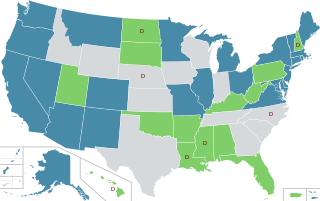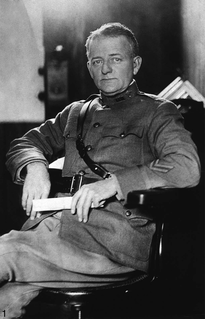Related Research Articles

Recreational drug use indicates the use of one or more psychoactive drugs to induce an altered state of consciousness either for pleasure or for some other casual purpose or pastime by modifying the perceptions and emotions of the user. When a psychoactive drug enters the user's body, it induces an intoxicating effect. Generally, recreational drugs are divided into three categories: depressants ; stimulants ; and hallucinogens.

The Marihuana Tax Act of 1937, Pub.L. 75–238, 50 Stat. 551, enacted August 2, 1937, was a United States Act that placed a tax on the sale of cannabis. The H.R. 6385 act was drafted by Harry Anslinger and introduced by Rep. Robert L. Doughton of North Carolina, on April 14, 1937. The Seventy-fifth United States Congress held hearings on April 27, 28, 29th, 30th, and May 4, 1937. Upon the congressional hearings confirmation, the H.R. 6385 act was redrafted as H.R. 6906 and introduced with House Report 792. The Act is now commonly referred to, using the modern spelling, as the 1937 Marijuana Tax Act. This act was overturned in 1969 in Leary v. United States, and was repealed by Congress the next year.

Harry Jacob Anslinger was a United States government official who served as the first commissioner of the U.S. Treasury Department's Federal Bureau of Narcotics during the presidencies of Herbert Hoover, Franklin D. Roosevelt, Harry S. Truman, Dwight D. Eisenhower, and John F. Kennedy. He was a supporter of Prohibition, and of the criminalization of drugs, and spearheaded anti-drug policy campaigns.
The gateway drug effect is a comprehensive catchphrase for the often observed effect that the use of a psychoactive substance is coupled to an increased probability of the use of further substances. Possible causes are biological alterations in the brain due to the earlier substance exposure and similar attitudes of people who use different substances across different substances. In 2020, the National Institute on Drug Abuse released a study backing allegations that marijuana is a "gateway" to more dangerous substance use, though not for the majority of people who use substances. A literature review by the United States Department of Justice found no conclusive evidence that the link is causal.

Cannabis, also known as marijuana among other names, is a psychoactive drug from the cannabis plant. Native to Central or South Asia, the cannabis plant has been used as a drug for both recreational and entheogenic purposes and in various traditional medicines for centuries. Tetrahydrocannabinol (THC) is the main psychoactive component of cannabis, which is one of the 483 known compounds in the plant, including at least 65 other cannabinoids, such as cannabidiol (CBD). Cannabis can be used by smoking, vaporizing, within food, or as an extract.

The Shafer Commission, formally known as the National Commission on Marihuana and Drug Abuse, was appointed by U.S. President Richard Nixon in the early 1970s. Its chairman was former Pennsylvania Governor Raymond P. Shafer. The commission issued a report on its findings in 1972 that called for the decriminalization of marijuana possession in the United States. The report was ignored by the White House, but is an important document against prohibition.

The LaGuardia Committee was the first in-depth study into the effects of smoking cannabis in the United States. An earlier study, the Indian Hemp Drugs Commission, was conducted by the colonial authorities in British India in 1893–94. The reports systematically contradicted claims made by the U.S. Treasury Department that smoking marijuana results in insanity, deteriorates physical and mental health, assists in criminal behavior and juvenile delinquency, is physically addictive, and is a "gateway" drug to more dangerous drugs.

Panama red, known as Panamanian red, or P.R. is a pure cultivar of Cannabis sativa, popular among cannabis users of the 1960s and 1970s, and renowned for its potency. The typically high THC levels associated with the variety are thought to be dependent on the particular cultivar, rather than the Panamanian climate. It induces a mellow cerebral high, slight body relaxation, characterized by euphoria and increase in energy, boosts creativity. It can cause anxiety and paranoia in some users.

In the United States, the non-medical use of cannabis is legalized in 21 states and decriminalized in 10 states as of November 2022. Decriminalization refers to a policy of reduced penalties for cannabis offenses, typically involving a civil penalty for possessing small amounts, instead of criminal prosecution or the threat of arrest. In jurisdictions without penalty the policy is referred to as legalization, although the term decriminalization is sometimes used for this purpose as well.

In the United States, increased restrictions and labeling of cannabis as a poison began in many states from 1906 onward, and outright prohibitions began in the 1920s. By the mid-1930s cannabis was regulated as a drug in every state, including 35 states that adopted the Uniform State Narcotic Drug Act. The first national regulation was the Marihuana Tax Act of 1937.

Colonel Joseph Franklin Siler, MD (1875–1960) was a U.S. Army physician noted for investigations of mosquito transmission of dengue fever in the Philippines and for Marijuana Smoking in Panama, one of the first experimental reports on cannabis.

An association between tobacco and other drug use has been well established. The nature of this association remains unclear. The two main theories, which are not mutually exclusive, are the phenotypic causation (gateway) model and the correlated liabilities model. The causation model argues that smoking is a primary influence on future drug use, while the correlated liabilities model argues that smoking and other drug use are predicated on genetic or environmental factors.
Edward M. Brecher (1912–1989) was an American science writer and book author, best known for his contributions in addiction research, human sexuality, and for his advocacy of rights for people who choose to commit suicide.
The National Conference of Commissioners on Uniform State Laws developed the Uniform State Narcotic Drug Act in 1934 due to the lack of restrictions in the Harrison Act of 1914. The Harrison Act was a revenue-producing act and, while it provided penalties for violations, it did not give authority to the states to exercise police power regarding either seizure of drugs used in illicit trade or punishment of those responsible.
Cannabis in Latvia is illegal for recreational and medical purposes, but production of industrial hemp is permitted.

Cannabis usage is currently prohibited in the United States military, but historically it has been used recreationally by some troops, and some cannabis-based medicines were used in the military as late as the twentieth century.

Terms related to cannabis include:

Licit and Illicit Drugs: The Consumers Union Report on Narcotics, Stimulants, Depressants, Inhalants, Hallucinogens, and Marijuana–including Caffeine, Nicotine and Alcohol is a 1972 book on recreational drug use by medical writer Edward M. Brecher and the editors of Consumer Reports.
During the administration of American President Richard Nixon (1969–1974), the United States turned to increasingly harsh measures against cannabis use, and a step away from proposals to decriminalize or legalize the drug. The administration began the War on Drugs, with Nixon in 1971 naming drug abuse as "public enemy number one in the United States."
References
- ↑ Madras & Kuhar 2013, p. 428.
- ↑ Booth 2005, p. 160.
- ↑ Swartz 2012, p. 82.
- ↑ Koop 1988, p. 368.
- ↑ Health, Education, and Welfare 1972.
- ↑ Licit and Illicit Drugs chapter 60, via Schaffer Library of Drug Policy
- ↑ Greenberg 1976.
- ↑ 50th Anniversary of First Pot Protest, California NORML, August 16, 2014
- ↑ Dufton 2017, p. 18.
Sources
- Swartz, James (2012). Substance Abuse in America: A Documentary and Reference Guide. ABC-CLIO. ISBN 978-0-313-35376-5 . Retrieved 2018-03-24.
- Madras, B.; Kuhar, M. (2013). The Effects of Drug Abuse on the Human Nervous System. Elsevier Science. ISBN 978-0-12-418685-9.
- Dufton, Emily (2017). Grass Roots: The Rise and Fall and Rise of Marijuana in America. Basic Books. ISBN 978-0-465-09617-6.
- Koop, C. Everett, ed. (1988), "Tobacco use compared to other dependencies", Health Consequences of Smoking: Nicotine Addiction, United States Department of Health and Human Services, ISBN 9780788123146
- Booth, M. (2005). Cannabis: A History. Picador. ISBN 978-0-312-42494-7.
- Greenberg, I.; et al. (J. Kuehnle, J.H. Mendelson) (1976), "Effects of Marihuana Use on Body Weight and Caloric Intake in Humans", Psychopharmacology, Springer-Verlag, 49 (79): 79–84, doi:10.1007/BF00427475, ISSN 0033-3158, PMID 822452, S2CID 1662989
- Marihuana and Health: Second Annual Report to Congress from the Secretary of Health, Education, and Welfare, U.S. Government Printing Office, May 1972, p. 128